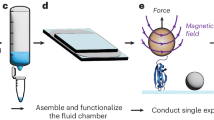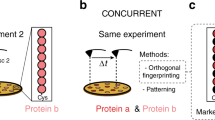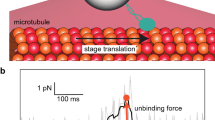Abstract
Strep-Tactin, an engineered form of streptavidin, binds avidly to the genetically encoded peptide Strep-tag II in a manner comparable to streptavidin binding to biotin. These interactions have been used in protein purification and detection applications. However, in single-molecule studies, for example using atomic force microscopy-based single-molecule force spectroscopy (AFM-SMFS), the tetravalency of these systems impedes the measurement of monodispersed data. Here, we introduce a monovalent form of Strep-Tactin that harbours a unique binding site for Strep-tag II and a single cysteine that allows Strep-Tactin to specifically attach to the atomic force microscope cantilever and form a consistent pulling geometry to obtain homogeneous rupture data. Using AFM-SMFS, the mechanical properties of the interaction between Strep-tag II and monovalent Strep-Tactin were characterized. Rupture forces comparable to biotin:streptavidin unbinding were observed. Using titin kinase and green fluorescent protein, we show that monovalent Strep-Tactin is generally applicable to protein unfolding experiments. We expect monovalent Strep-Tactin to be a reliable anchoring tool for a range of single-molecule studies.
This is a preview of subscription content, access via your institution
Access options
Subscribe to this journal
Receive 12 print issues and online access
$259.00 per year
only $21.58 per issue
Buy this article
- Purchase on Springer Link
- Instant access to full article PDF
Prices may be subject to local taxes which are calculated during checkout




Similar content being viewed by others
References
Eakin, R. E., McKinley, W. A. & Williams, R. J. Egg-white injury in chicks and its relationship to a deficiency of vitamin H (biotin). Science 92, 224–225 (1940).
Gyorgy, P. & Rose, C. S. Cure of egg-white injury in rats by the ‘toxic’ fraction (avidin) of egg white given parenterally. Science 94, 261–262 (1941).
Tausig, F. & Wolf, F. J. Streptavidin—a substance with avidin-like properties produced by microorganisms. Biochem. Biophys. Res. Commun. 14, 205–209 (1964).
Bayer, E. A., Skutelsky, E., Wynne, D. & Wilchek, M. Preparation of ferritin–avidin conjugates by reductive alkylation for use in electron microscopic cytochemistry. J. Histochem. Cytochem. 24, 933–939 (1976).
Heggeness, M. H. & Ash, J. F. Use of the avidin–biotin complex for the localization of actin and myosin with fluorescence microscopy. J. Cell Biol. 73, 783–788 (1977).
Bayer, E. A., Zalis, M. G. & Wilchek, M. 3-(N-maleimido-propionyl)biocytin: a versatile thiol-specific biotinylating reagent. Anal. Biochem. 149, 529–536 (1985).
Schatz, P. J. Use of peptide libraries to map the substrate specificity of a peptide-modifying enzyme: a 13 residue consensus peptide specifies biotinylation in Escherichia coli. Nature Biotechnol. 11, 1138–1143 (1993).
Beckett, D., Kovaleva, E. & Schatz, P. J. A minimal peptide substrate in biotin holoenzyme synthetase-catalyzed biotinylation. Protein Sci. 8, 921–929 (1999).
Moy, V. T., Florin, E. L. & Gaub, H. E. Intermolecular forces and energies between ligands and receptors. Science 266, 257–259 (1994).
Florin, E. L., Moy, V. T. & Gaub, H. E. Adhesion forces between individual ligand–receptor pairs. Science 264, 415–417 (1994).
Voss, S. & Skerra, A. Mutagenesis of a flexible loop in streptavidin leads to higher affinity for the Strep-tag II peptide and improved performance in recombinant protein purification. Protein Eng. 10, 975–982 (1997).
Schmidt, T. G., Koepke, J., Frank, R. & Skerra, A. Molecular interaction between the Strep-tag affinity peptide and its cognate target, streptavidin. J. Mol. Biol. 255, 753–766 (1996).
Schmidt, T. G. & Skerra, A. The Strep-tag system for one-step purification and high-affinity detection or capturing of proteins. Nature Protoc. 2, 1528–1535 (2007).
Nampally, M., Moerschbacher, B. M. & Kolkenbrock, S. Fusion of a novel genetically engineered chitosan affinity protein and green fluorescent protein for specific detection of chitosan in vitro and in situ. Appl. Environ. Microbiol. 78, 3114–3119 (2012).
Knabel, M. et al. Reversible MHC multimer staining for functional isolation of T-cell populations and effective adoptive transfer. Nature Med. 8, 631–637 (2002).
Moosmeier, M. A. et al. Transtactin: a universal transmembrane delivery system for Strep-tag II-fused cargos. J. Cell. Mol. Med. 14, 1935–1945 (2010).
Lim, K. H., Huang, H., Pralle, A. & Park, S. Stable, high-affinity streptavidin monomer for protein labeling and monovalent biotin detection. Biotechnol. Bioeng. 110, 57–67 (2013).
Howarth, M. et al. A monovalent streptavidin with a single femtomolar biotin binding site. Nature Methods 3, 267–273 (2006).
Lau, P. W. et al. The molecular architecture of human Dicer. Nature Struct. Mol. Biol. 19, 436–440 (2012).
Sauerwald, A. et al. Structure of active dimeric human telomerase. Nature Struct. Mol. Biol. 20, 454–460 (2013).
Howarth, M. et al. Monovalent, reduced-size quantum dots for imaging receptors on living cells. Nature Methods 5, 397–399 (2008).
Carlsen, A. T., Zahid, O. K., Ruzicka, J. A., Taylor, E. W. & Hall, A. R. Selective detection and quantification of modified DNA with solid-state nanopores. Nano Lett. 14, 5488–5492 (2014).
Sonntag, M. H., Ibach, J., Nieto, L., Verveer, P. J. & Brunsveld, L. Site-specific protection and dual labeling of human epidermal growth factor (hEGF) for targeting, imaging, and cargo delivery. Chemistry 20, 6019–6026 (2014).
Xie, J. et al. Photocrosslinkable pMHC monomers stain T cells specifically and cause ligand-bound TCRs to be ‘preferentially’ transported to the cSMAC. Nature Immunol. 13, 674–680 (2012).
Merkel, R., Nassoy, P., Leung, A., Ritchie, K. & Evans, E. Energy landscapes of receptor–ligand bonds explored with dynamic force spectroscopy. Nature 397, 50–53 (1999).
Kim, M., Wang, C. C., Benedetti, F. & Marszalek, P. E. A nanoscale force probe for gauging intermolecular interactions. Angew. Chem. Int. Ed. 51, 1903–1906 (2012).
Chilkoti, A., Boland, T., Ratner, B. D. & Stayton, P. S. The relationship between ligand-binding thermodynamics and protein–ligand interaction forces measured by atomic force microscopy. Biophys. J. 69, 2125–2130 (1995).
Tang, J. et al. Recognition imaging and highly ordered molecular templating of bacterial S-layer nanoarrays containing affinity-tags. Nano Lett. 8, 4312–4319 (2008).
Puchner, E. M. et al. Mechanoenzymatics of titin kinase. Proc. Natl Acad. Sci. USA 105, 13385–13390 (2008).
Li, Y. D., Lamour, G., Gsponer, J., Zheng, P. & Li, H. The molecular mechanism underlying mechanical anisotropy of the protein GB1. Biophys. J. 103, 2361–2368 (2012).
Zocher, M. et al. Single-molecule force spectroscopy from nanodiscs: an assay to quantify folding, stability, and interactions of native membrane proteins. ACS Nano 6, 961–971 (2012).
Schmidt, T. G. et al. Development of the twin-Strep-tag(R) and its application for purification of recombinant proteins from cell culture supernatants. Prot. Expr. Purif. 92, 54–61 (2013).
Moayed, F., Mashaghi, A. & Tans, S. J. A polypeptide–DNA hybrid with selective linking capability applied to single molecule nano-mechanical measurements using optical tweezers. PLoS ONE 8, e54440 (2013).
Evans, E. & Ritchie, K. Dynamic strength of molecular adhesion bonds. Biophys. J. 72, 1541–1555 (1997).
Bell, G. I. Models for the specific adhesion of cells to cells. Science 200, 618–627 (1978).
Moosmeier, M. A., Bulkescher, J., Hoppe-Seyler, K. & Hoppe-Seyler, F. Binding proteins internalized by PTD-fused ligands allow the intracellular sequestration of selected targets by ligand exchange. Int. J. Mol. Med. 25, 557–564 (2010).
Kim, M. et al. Nanomechanics of streptavidin hubs for molecular materials. Adv. Mater. 23, 5684–5688 (2011).
Korndorfer, I. P. & Skerra, A. Improved affinity of engineered streptavidin for the Strep-tag II peptide is due to a fixed open conformation of the lid-like loop at the binding site. Protein Sci. 11, 883–893 (2002).
Weber, P. C., Ohlendorf, D. H., Wendoloski, J. J. & Salemme, F. R. Structural origins of high-affinity biotin binding to streptavidin. Science 243, 85–88 (1989).
Chivers, C. E. et al. A streptavidin variant with slower biotin dissociation and increased mechanostability. Nature Methods 7, 391–U376 (2010).
Malmstadt, N., Hyre, D. E., Ding, Z., Hoffman, A. S. & Stayton, P. S. Affinity thermoprecipitation and recovery of biotinylated biomolecules via a mutant streptavidin-smart polymer conjugate. Bioconjug. Chem. 14, 575–580 (2003).
Pippig, D. A., Baumann, F., Strackharn, M., Aschenbrenner, D. & Gaub, H. E. Protein–DNA chimeras for nano assembly. ACS Nano 8, 6551–6555 (2014).
Schmidt, T. G. & Skerra, A. One-step affinity purification of bacterially produced proteins by means of the ‘Strep tag’ and immobilized recombinant core streptavidin. J. Chromatogr. A 676, 337–345 (1994).
Jain, A., Liu, R., Xiang, Y. K. & Ha, T. Single-molecule pull-down for studying protein interactions. Nature Protoc. 7, 445–452 (2012).
Celik, E. & Moy, V. T. Nonspecific interactions in AFM force spectroscopy measurements. J. Mol. Recogn. 25, 53–56 (2012).
Limmer, K., Pippig, D. A., Aschenbrenner, D. & Gaub, H. E. A force-based, parallel assay for the quantification of protein–DNA interactions. PLoS ONE 9, e89626 (2014).
Otten, M. et al. From genes to protein mechanics on a chip. Nature Methods 11, 1127–1130 (2014).
Beckmann, A. et al. A fast recoiling silk-like elastomer facilitates nanosecond nematocyst discharge. BMC Biol. 13, 3 (2015).
Zimmermann, J. L., Nicolaus, T., Neuert, G. & Blank, K. Thiol-based, site-specific and covalent immobilization of biomolecules for single-molecule experiments. Nature Protoc. 5, 975–985 (2010).
Acknowledgements
This work was supported by the European Research Council (Cellufuel, Advanced Grant 294438) and the German Research Foundation (SFB1032-A01). The authors thank M. Gautel for providing the titin kinase construct, IBA for providing unmodified Strep-Tactin, M.A. Jobst for AFM software implementation, W. Ott for discussions, S.W. Stahl and A. Zeder for initial tests with Strep-Tactin in AFM force spectroscopy, K. Erlich for proof reading and A. Kardinal and T. Nicolaus for laboratory support.
Author information
Authors and Affiliations
Contributions
H.E.G. and D.A.P. conceived the idea and designed the experiments. Experiments were carried out and evaluated by F.B., M.S.B. and D.A.P. L.F.M. provided force spectroscopy evaluation software and advice. A.A. prepared TK. D.A.P. wrote the manuscript with input from all authors.
Corresponding author
Ethics declarations
Competing interests
The authors declare no competing financial interests.
Supplementary information
Supplementary information
Supplementary information (PDF 3568 kb)
Rights and permissions
About this article
Cite this article
Baumann, F., Bauer, M., Milles, L. et al. Monovalent Strep-Tactin for strong and site-specific tethering in nanospectroscopy. Nature Nanotech 11, 89–94 (2016). https://doi.org/10.1038/nnano.2015.231
Received:
Accepted:
Published:
Issue Date:
DOI: https://doi.org/10.1038/nnano.2015.231
This article is cited by
-
Functional expression of monomeric streptavidin and fusion proteins in Escherichia coli: applications in flow cytometry and ELISA
Applied Microbiology and Biotechnology (2018)



